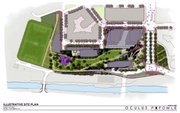Site plan for the 5 acres of proposed green space to support the growing number of residents and workers in the Carlyle Towers area.
Alexandria — On June 16, city council voted 7-0 in approval of Carlyle Plaza and Alex Renew's "green block," or about 5 acres of proposed green space off of Eisenhower Avenue. The project confronts several architectural and environmental challenges to provide an open green space for the growing number of residents and workers in the Carlyle Towers area.
"There were so many complex constraints," said Dan Kaplan, architect from FX Fowle, "we really needed to be facile to solve them."
First, Carlyle Plaza must create a green space to comply with Alexandria's Green Building Policy. Since 2009, Alexandria has required all new developments to meet LEED silver standards. LEED silver requires buildings to meet at least 50 points across five different categories: sustainable sites, water efficiency, energy and atmosphere, materials and resources, and indoor environmental quality.
Additionally, Carlyle Plaza must build a parking garage to serve the growing number of residents.
Secondly, Alex Renew, formerly known as the Alexandria Sanitation Authority, must abide local and state environmental laws. Along with LEED silver accreditation, Alex Renew must comply with Virginia's Chesapeake Bay Preservation Act, which requires a reduction of 62 percent nitrogen from the treated wastewater. With Alexandria's projected population of 25 percent in 40 years, increased efficiency in wastewater treatment alongside increased urbanization is a concern.
Finally, the development is to be built on contaminated soil. Throughout the early and mid part of the twentieth century, the area was home to a municipal incinerator, which would cover the soil in ash. Furthermore, many local residents would use the space to dump used appliances. As a result, many metals, paper, glass, ash, and even petroleum have contaminated the soil.
Since then, the land has been reclaimed. However, no developer is allowed to dig more than 18 inches into the soil. This makes a standard green space almost impossible to develop.
WITH THESE CHALLENGES before them, Carlyle Plaza contracted landscapers and architects from the firms, Oculus and FX Fowle, to find a solution.
What the Alex Renew and Carlyle Plaza showed to the City Council on June 16 was an integrated urban green space. The two entities had two different goals: Alex Renew needed build sewage tanks to accommodate a growing population, and Carlyle Plaza needed to build both a green space and a parking garage for their new development. Therefore, Alex Renew revealed a $100 million plan for sewage tanks to be concealed by a multipurpose field, which is to be integrated with Carlyle Plaza's green space.
"Everything had to be integrated," said Kaplan, "the wastewater, the green space, the parking, the network of open space, and the architecture had to be integrated."
To resolve the density issue, designers decided to create the green space on top of an above ground parking garage. The space includes an open field, trees, and a "creative play" area, a space where children can play on rolling hills and valleys.
"As a mother, I am very excited for the play area," said Karen Pallansch, CEO of Alex Renew, "this is more open and unstructured."
To treat the runoff water, developers designed a series of bio-filters along the stair entrance. Thus, the runoff will be treated and later used to irrigate the open spaces and fill the nearby water feature.
Because accessibility was another concern, designers included a pedestrian-bike path that connects the green space to the ground level. The path will be connected to the greater Mount Vernon bike trail, and will have a gradient of 5 degrees to allow for an easy walk or ride.
Finally, the sewage treatment tanks will be concealed by an open, multi-purpose field. "I would see the pocket parks where people will fill them up," said Carlyle resident Bill Harvey, commenting on the need for a field, "there would be 30 to 40 people fill up these little spaces."
"There's been a lot of talk of sustainable development, but the big strength of this is that this is really green urbanism," said Kaplan, "it's less about the performance of each individual building, it's about the performance of the whole project."
Harvey, who also worked for the Army Corps of Engineers for 28 years, applauded the design. "I've been a supporter from the beginning," said Harvey, "and I think their design has improved from the beginning. And they are not finished yet."
Excavation is to begin spring 2013, but could begin as early as fall 2012. The project should be "mostly done" by 2016, said Pallansch.




